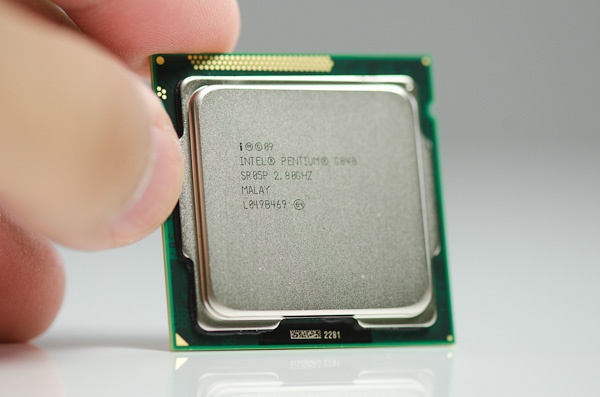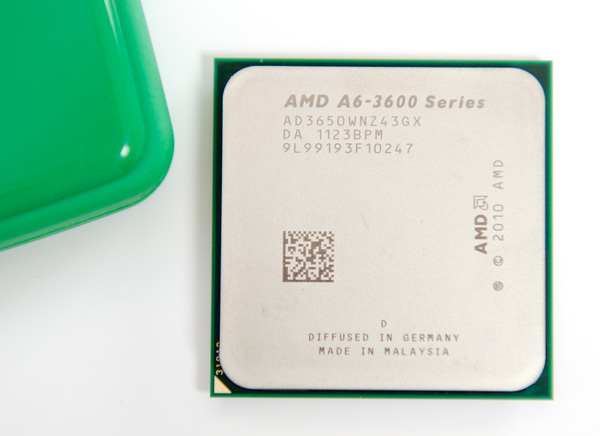The Sandy Bridge Pentium Review: G850, G840, G620 & G620T Tested
by Anand Lal Shimpi on August 23, 2011 12:11 AM ESTFinal Words
Despite boasting Intel's latest Sandy Bridge microarchitecture, the conclusions here are pretty much unchanged from the past. Intel maintains an advantage when it goes up against an AMD chip with the same number of cores, almost regardless of clock speed. In the case of the Pentium G620, even an Athlon II X2 265 with a 27% clock speed advantage can't outperform the Sandy Bridge based CPU. If you're choosing between chips with the same number of cores at the same price, Intel wins.
The decision tilts in AMD's favor if you start comparing to the Athlon II X3. In heavily threaded workloads, the Athlon II X3's third core helps put it ahead of the entire SNB Pentium lineup. If you're building a machine to do offline 3D rendering, multithreaded compiling or video transcoding then AMD continues to deliver the best performance per dollar. It's in the lighter, less threaded workloads that the Pentium pulls ahead. If you're building more of a general use system (email, web browsing, typical office applications and even discrete GPU gaming), the Pentium will likely deliver better performance thanks to its ILP advantages. What AMD has offered these past couple of years is an affordable way to get great multithreaded performance for those applications that need it.
Unfortunately the entire Sandy Bridge Pentium lineup is clock locked. Without turbo modes there's no support for overclocking at all. While these new Pentiums would have normally been great for enthusiasts looking to overclock, Intel has ensured that anyone looking to get more performance for free at the low end will have to shop AMD. Unfortunately Intel's advantage in single/lightly threaded performance is big enough that a clock speed advantage alone is generally not enough to make up for it (see G620 vs. Athlon II X2 265 comparison). It's sad that it has come to this. I was hoping we'd see more K-series SKUs at the low end but it seems like those will only be for the enthusiasts at the high end.
The Pentium's on-die GPU isn't particularly impressive. It's the HD Graphics 2000 from the rest of the Sandy Bridge lineup without Quick Sync or any of the extra video features. I am particularly sad that Quick Sync is missing as it would've made these Pentiums extremely attractive for users that do a lot of video transcoding. Thankfully video decode acceleration and HD audio bitstreaming support remain, so if you're looking to build a cheap Sandy Bridge based HTPC and don't care about the frills these chips will work just fine.
However, if you're building a system to do any sort of 3D gaming you're much better off either springing for a cheap discrete card or looking at AMD's A6-3650 if you want to stay integrated. Although you can play older titles at low resolution on the Pentium's on-board GPU, you'll have a much better experience with a discrete GPU or with the A6.
It all boils down to this. If you want a good, cheap, general purpose PC then the Pentium G620 seems competent and cheap. You can consider the G840 if you want a bit more performance. If you do a lot of threaded work (e.g. offline 3D rendering) the next step up is the Athlon II X3 455. If you do any amount of consumer level video transcoding using apps that are Quick Sync enabled, opt for the Core i3 2100 instead. If gaming is important to you then either buy a discrete GPU or look to AMD's Llano.
As far as AMD's A6 vs. A8 goes, the A8-3850 only commands a $20 price premium over the A6-3650. That $20 gives you another 8 - 10% on the CPU side and around 20% on the GPU. In my opinion, if you're considering a Llano system - spring for the A8.












110 Comments
View All Comments
yankeeDDL - Monday, September 5, 2011 - link
Averik, positive exchange of opinion and ideas is always nice, I think :)I wrote another comment a few pages down about comparing power consumption.
It is very difficult to compare power consumption based on the data above, however, a "quick and dirty" comparison can be done using the data from the graphs of the H264 decoding and the power under load.
You can see that the G620 uses 55% of the power of the X3, but the X3 takes 60% of the time to do the compression.
What this means is that under load, the G620 consumes less, but the X3 goes back idle much faster than the G620. Of course, this is one specific scenario: in general, it's clear that the G620 is more efficient, but also slower.
Considering the type of applications you indicate, I think the amount of time when the system will be at max power will be extremely low, compared to the idle time.
Unfortunately Anand did not compare the idle power consumption between these CPUs.
This page compares system level power consumption of both the X3 and the G620 (http://www.xbitlabs.com/articles/cpu/display/penti... and shows again the X3 on top. In the comment you see that with other MoBos the G620 idle power can be shaver a little and be made, at best, the same.
So I stand by my position: the G620 offers no advantage over the Athlon X3, and this includes power consumption considerations (at system level, which is what matters). Considering the price difference and the 3rd core, I would not consider the low-end sandy bridge for my budget PCs.
CeriseCogburn - Thursday, January 3, 2013 - link
Exactly, and that newer platform has a gigantic upgrade path years from now while the amd system has jack nothing.When the company wants to throw the systems away, all the employees will want one because they can drop a 2500K in it for the $50 it will cost then, and have a freaking screamer of system again. Or one of the new IB's.
The amd boards won't make it in tact to the trash bin. No one will want them.
TypeS - Thursday, August 25, 2011 - link
Brand recognition, plain and simple. That is why Intel releases these chips and why they will sell. Agree with the ways Intel has grown in the last 2 decades, they have the market leader spot and will use it. Intel was the company that created the x86 design and AMD would be nothing today without it's tech and government forcing cross-licensing agreements down Intel's throat.Remember the percentage of us that actually read these reviews, go to these websites and know that actual statistics of all the various PC components is pretty small compared to the size of the consumer market. People usually walk into a Best Buy (or other big box store) and see two things to base their decisions on, brand and price.
You see the same with cars. People buy the ridiculously overpriced german, italian and bristish "luxury" cars when the same quality can be found in premium Japanese cars and some luxury American models. It's brand recognition. Who wins in performance charts means little in the end.
CeriseCogburn - Thursday, January 3, 2013 - link
A few year down the line in hoes the IB or 2500K or 2600K and suddenly the piece of crap is a MONSTER.The amd board - stomp it. It loses, screw any upgrade.
Oh look at that... only a freaking fool would buy the amd rig now.
JD_Mortal - Monday, May 6, 2013 - link
Because 90% of computer users only do "basic stuff" with thier computers.Because, AC is more expensive than heat.
Because having 2000 computers that constantly draw 95Watts at idle, and not being used, is more expensive to operate for four years, than 2000 running at 23Watts at idle.
Because "We" (the people buying them, who are the majority of sales), keep asking for it. Thus, fueling the few sales and development of YOUR overpriced and over powered (wattage-power), making them within your actual budget. (Without OUR sales, YOUR chips would still be on 65nm, and cost $1000 per CPU. Oh, you are welcome BTW.)
algida79 - Tuesday, August 23, 2011 - link
Hi Anand. I think that the phrasing under the x264 comparison charts:"Without Quick Sync, the Pentiums have to rely on raw CPU power for video encoding performance."
is a bit misleading. It implies that the presence of QuickSync would benefit the Pentiums' performance in x264 encoding, which is not the case.
Anand Lal Shimpi - Tuesday, August 23, 2011 - link
Very true - fixed :)Take care,
Anand
Arnulf - Tuesday, August 23, 2011 - link
How about that par2 test, is it true that the lower clock A6-3650 is faster at this one than A8-3850 ?ckryan - Tuesday, August 23, 2011 - link
But I don't think the celeron line deserves to continue.These Pentiums aren't unattractive neccessarily. If you think about it, they're faster than a comparable i3-5xx series, have better IGPs and use less power. You can't over clock them, nor can they hyperthread, but they're not useless. The celeron line refresh is a different story -- though I suppose you could say the 1155 celerons are the best ever... not that it's saying much. I have a spare 1155 H67 board laying around that could be inexpensively outfitted with a Pentium for not much cash, but the question remains whether the Athlon II X3 it would replace would be better served by retirement. The answer is probably no -- it's not worth the $78 for a lateral move. If you're building a budget system from scratch you'll probably need to decide whether a super cheap H61 board and a Pentium is a good investment, and I think most people would be better served with an Athlon II system if you can't fit Llano or a H67/z68 i3 setup into your budget. But if you're in the market, a G620/H61/4GB DDR3/Rosewill Case and PSU combo is less than $200 at Newegg. So I'd say buy whatever is on sale. Add $120 for a cheap SSD and DVD burner and you have a system that could do everything but game, or choose to get a entry level GPU like the 6600 series and you could game pretty well for such a modest system.
CeriseCogburn - Monday, June 25, 2012 - link
The problem with your thinking is after some time one can drop a 2500K SB in the dirt cheap pentium board and be miles ahead of any amd setup, which cannot and will not do the same thing.So if you go amd you've screwed yourself forever.